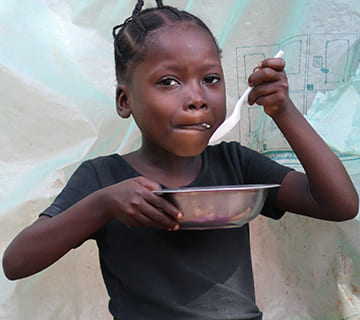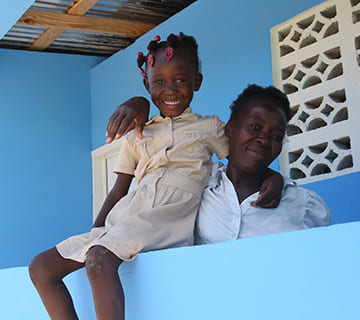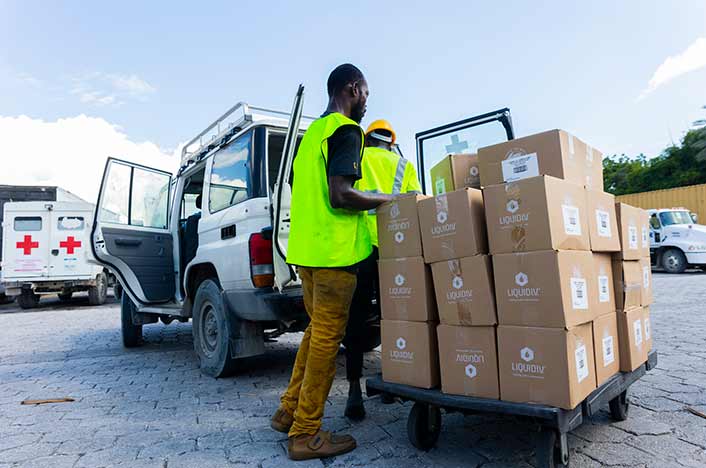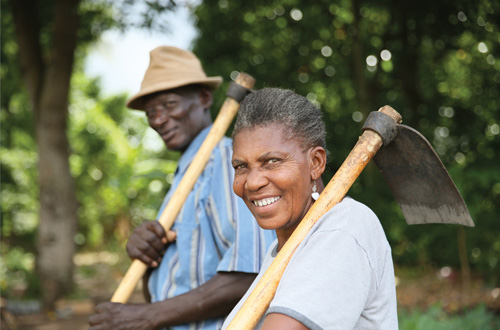
How We Help
Food For The Poor strives to lift the poor out of poverty.
- In 2023, we shipped 2,528 tractor-trailer loads of aid delivered.
- In the first six months of 2020, we built, repaired or expanded 21 schools, and shipped 133 tractor-trailer loads of school furniture, books and educational supplies to schools.
- Since mid-March we have shipped more than 200 containers specifically for COVID-19 relief.
What Is Poverty?
The simplest way to explain poverty is that poverty happens when you cannot afford life’s necessities – food, water and shelter.
Many examples of extreme poverty in the Caribbean and Latin America include families deciding what is most important to purchase with the only money they might have – food, water or rent?
Like the mother who lived in a chicken coop in Jamaica because it was free, and she could use the tiny bit of money she earned from work to buy food for her children.
Or a mother in Haiti who begged on the street for food during the day and slept in a church at night so her children would be safe.
5 types of poverty found globally:
1. Rural and urban poverty
If a family lives in a remote region or in the heart of a city in the Caribbean or Latin America, poverty can strike with devastating severity.
In rural areas, families who own land, likely passed down over many generations, have slightly more security and the chance to grow crops and raise animals – if they have the money to get these types of projects started.
In big cities, poverty forces families to make hard choices to provide for their children. Some will send a child to work as a domestic helper in another person’s home. Others will leave their children behind with a family member while they work far from home.
2. Multidimensional poverty
UNICEF reported that multidimensional poverty in children rose to 1.2 billion in September 2020 as the crushing effects of job loss and sickness from the COVID-19 pandemic began to show.
Multidimensional poverty happens when a person suffers from more than one issue relating to poverty.
For example, a mother may be sickly but not have access to health care; a father may be able to farm, but his land is experiencing a drought and there are no crops, or a family may have shelter but no electricity, water or sanitation.
Multidimensional poverty looks at a broad picture of how and why a family is hugely impoverished not just at one aspect of their situation, like an income.
A single mother faces multidimensional poverty in Latin America
Heartbreaking choices are made when families are faced with the challenges of poverty. When deciding whether to give her four children either a safe shelter to live in or food to fill their hungry stomachs, Suyapa, 28, made the difficult choice. She moved her family from a solid home on a hill to a plot of dirt below it next to a busy road.
She was renting a home above her current house for the equivalent of $20 per month, not including water. “I still owe money on the rent,” Suyapa said. “They are asking me for the rent. … I tell them I have to feed my children first.”
Suyapa began building a makeshift house to shelter her three boys and daughter. The cycle of poverty continues.
Her husband left a couple of years ago to make money on the coast of Honduras and Suyapa hasn’t seen him since. “I built the house myself. It took about a month because I am by myself,” she said.
“The nylon and tarps were given to me, and I went into the forest for the wood,” Suyapa said. “The other house had a better roof and mud-and-stick walls, but I had to feed my children.”
To feed her family, Suyapa works picking beans or coffee and must bring all her children with her. The family has a system in the field: Ronney, 10, picks 2 gallons worth of beans. Miguel, 7, takes care of his younger sister, Josselyn, 2, and Orlin, 5, picks up the beans that fall to the ground.
Often, Suyapa doesn’t make enough money to feed the family. “We almost always come home to no food for dinner,” Suyapa said. “When I don’t have it, I have to beg for it. When I have food, I try to feed my children three times a day, even if I don’t eat.”
Suyapa does her best to comfort her children. “I tell them, ‘What can I do? I have no food.’ They understand,” Suyapa said. “I feel very bad because I cannot provide, and there is so much I want to give, but over time they understand, and they don’t ask as much.”
Every day, Suyapa glanced up at the house on the hill where they used to live and tried to convince herself she made the right decision, even though she still struggled. “I get frustrated when I don’t have the courage. It happens almost every day when I think, ‘What am I going to do to provide for them,’ but then I keep going,” Suyapa said.
Overcoming poverty one house at a time
Fortunately, donors and friends of Food For The Poor stepped in and paid Suyapa’s debt – about $100 – a debt that would have taken her a lifetime to pay off, and they built her a new safe home. Suyapa went from poverty to a sustainable life and a brighter future.
3. Absolute poverty
Absolute poverty is when a family doesn’t have the minimum amount of money to pay for their most basic and immediate needs.
4. Situational poverty
When a hurricane, mudslide or natural disaster strikes, it can cause a temporary loss of income. This can push a family into situational poverty, something that most impoverished families cannot bounce back from without help.
5. Intergenerational poverty
When more than one generation is born into poverty, this family is experiencing intergenerational poverty.
8 threats that drive poverty
It’s normal to wonder why a child isn’t in school, why a mother hasn’t gotten her sick child to a doctor or why a father isn’t providing for his children when he can work. Or to wonder, when you see a photo of a family huddled together in a terrible house made from scraps, why they don’t live someplace safer.
Trapped in a cycle
In developing countries, poverty and hunger disproportionately affects women and children.
In the vicious cycle of poverty, the suffering of women and children exceeds that of men. Women often are the sole caregivers for their children and do not have the chance to work. If they work, it’s usually washing clothes or cleaning, and it doesn’t pay enough to save for anything.
Many mothers living in poverty must spend what they earn daily on basic needs, with little to no money left over to save in case of illness or a job loss.
If her children are old enough, they will have to step in to help earn money, robbing them of any chance to go to school. An education would help break the cycle of poverty.
One out of six children globally lived in extreme poverty before the pandemic. They will stay trapped in their impoverished conditions unless they have a way out through access to education, health care and job opportunities
Globally, around 700 million people live in extreme poverty – that’s about 10 percent of the world’s population earning less than $2.15 a day. So a morning cup of coffee can cost more than a highly impoverished person will make in one day.
Absolute poverty has carried on within families and communities in developing countries across the Caribbean and Latin America for decades. Poverty is multidimensional and complex.
Let’s look at eight of the biggest factors that drive poverty in developing countries.
1. Social and economic inequality
Inequality is an excellent place to start because inequality is pervasive in many rural and urban communities.
Depending on gender, the tribe they belong to in their community, race or religion, people routinely get denied access to jobs, education, clean water and safe shelter.
If a parent was denied access to an education and cannot read or write or send their own children to school, a foundation for a better life is nonexistent.
2. Violence and civil unrest
There is civil unrest and gang violence in some countries in the Caribbean and Latin America. When conflict arises, it can become unsafe to leave your home, which means a parent cannot work to earn money to feed their children or send them to school.
3. Natural disasters, environment and climate change
Since many families earn only enough to buy a little food each day, it can devastate families and communities when a natural disaster strikes.
For example, when a hurricane rips through a community, it can destroy houses, livestock and crops. It is nearly impossible for families with no savings to put their lives back together without help.
When food becomes harder to grow due to an increase in floods and droughts, the price of food goes up and can leave impoverished families unable to afford or have access to healthy foods.
4. Hunger and malnutrition
When a person is hungry and has no means to buy nutritious food, this can lead to malnourishment. Malnourishment weakens their immune system and leaves them open to getting sick quickly.
When they are weak from hunger, they won’t be strong enough to work. In children, malnutrition leads to wasting and stunting, which can be deadly.
If a child survives malnutrition but experiences stunted growth, their earning potential over their lifetime is significantly lower than that of a healthy child.
5. Inadequate healthcare systems
Treatable illnesses like asthma and diarrhea can be a death sentence for a sick child living in a needy family.
Without medical care, an infant is at high risk for many health-related issues in the first several months of life.
If there isn’t a nearby clinic with free or low-cost health care available, vulnerable families must travel far from their homes to reach a hospital or clinic. The money it costs to take a bus can deplete any money a family might have saved, pushing them deeper into poverty.
6. Public infrastructure
What happens when a road is blocked on your way to work? You will typically get routed to another lane. But what if you live in a rural area with only one road? You cannot go to work. A lack of quality public infrastructure can affect many public places and systems operated by governments like public hospitals and schools, roads, bridges, public transportation, water and sewage, electricity and public parks.
7. No access to clean water
When an impoverished family has no access to water, women and children spend hours walking to a water source that sometimes contains contaminated water for their families.
Instead, hours spent walking could be time spent working or in school getting an education – both ways to break the cycle of poverty.
8. Lack of government support
In the United States, we have social welfare and other programs in place to help after natural disasters and during hard times.
But in the developing countries of the Caribbean and Latin America, this type of support is not readily available.
Without the help of a local government to provide relief and rehabilitation, most families fall deeper into debt and extreme poverty.
How can we end global poverty?
By reminding ourselves that we all need each other.
God uses you to help the needy
“There will always be poor people in the land.” (Deuteronomy 15:11, NIV)
God commanded us not to turn away from those in need but to open our hands in both material and spiritual ways.
When you give to end poverty, you are opening your hands and helping someone who is suffering. In return, what you receive is the motivation to continue living out the Gospel.
Take action to alleviate poverty
The gospel of Christ invites each of us to reach out to our brothers and sisters living in extreme poverty.
As a Food For The Poor supporter, you can share your blessings with vulnerable families and communities who need you.
Your love for God endures and grows by providing education, food, housing, health care and other forms of relief and sustainable actions to children and families who need you.
Thank you for addressing poverty and obediently answering God’s command to never forget our impoverished brothers and sisters. United in God’s work, together we will fight to end poverty now.
Other Ways to Give





